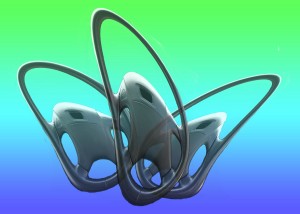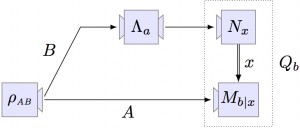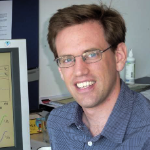CNQO Twitter Newsfeed
Seminar by Prof. Laurent Sanchez-Palencia
Where : in room JA.811
When: on the 28th of April 2017 at 10 Am
Title: Spreading of Quantum Correlations in Short- and Long-Range Interacting Systems
Abstract: The out-of-equilibrium dynamics of correlated quantum systems is attracting considerable attention sparked by the emergence of new quantum devices that combine long coherence times, slow dynamics, and precise control of parameters. They concern a variety of systems including ultracold atoms, artificial ion crystals, electronic circuits, spin chains in organic conductors, and quantum photonic systems for instance. One of the most fundamental features of the dynamics of quantum systems is the existence of so-called Lieb-Robinson bounds to the propagation of correlations. Such bounds have fundamental implications on propagation of information, spreading of quantum correlations, and the dynamics of thermalization processes.
Here, we study the dynamics of quantum correlations in various lattice systems using a combination of numerical and analytical many-body approaches. For quantum systems with short-range interactions, our results confirm ballistic spreading of quantum correlations in 1D and 2D Bose-Hubbard models and allow for accurate determination of the cone-like velocity. In dimension higher than two, we show that the correlation pattern is determined by many-body interference effects and that the wave front is characterized by a ballistic spreading within the Manhattan metrics rather than Euclidian metrics, hence producing a square rather than circular correlation front.
In long-range interacting systems, various extensions of the Lieb-Robinson bounds have been proposed. For interactions decaying algebraically in space like 1/R^a in a square lattice of dimension D, universal bounds predict super- ballistic spreading for a > D and no bound for a<=d. While compatible with those bounds, our results show that
(i) the quantum speed limit set by Lieb-Robinson bounds is most often not reached,
(ii) the spreading of quantum correlations is often sub-ballistic, and that it is both
(iii) model-dependent and
(iv) observable-dependent.
These conclusions are based on the systematic numerical study of the dynamics of two models characterized by the same universal bounds but that show completely different behaviors and on the study of various observables. These two models, namely the extended Ising and Bose-Hubbard models, are realizable within ultracold atom or ion systems. The numerics are both qualitatively and quantitatively supported by an analytical approach based on exact dynamics of many-body excitations.
Our results shed new light on the dynamics of quantum correlations in short- and long-range interacting systems. They pave the way to future experimental investigations and application to quantum communications in new engineered quantum devices.
Polarization Structured Beams go the Extra Mile
Light beams that can propagate without a significant change to their spatial profile are of interest for modern optical technologies and high-power laser systems. Self-trapped light filaments, or spatial solitons, are formed when the spreading due to linear diffraction is carefully balanced by a self-focusing (Kerr) nonlinearity that causes the beam to narrow. Because of their potential to carry an increased information content, there has been significant interest in the formation of spatial solitons carrying orbital angular momentum (OAM) for high-bandwidth communications protocols. However, even with saturable self-focusing media, it is known that optical beams with OAM will fragment into multiple solitons each possessing particle-like attributes.
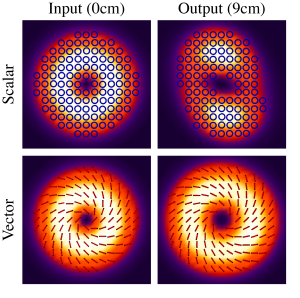 In a recent Physical Review Letters (Phys. Rev. Lett. 117, 233903, 2016) Alison M. Yao, Christopher Travis and Gian-Luca Oppo of the CNQO group in the Department of Physics, in collaboration with Robert Boyd’s group at the University of Ottawa in Canada, demonstrated both numerically and experimentally that propagation of OAM-carrying beams is more stable if the polarization is spatially structured. By studying the nonlinear optical propagation of two different classes of fully-structured light beams – vector vortex beams and full Poincaré beams – in a rubidium vapour cell they observed that their propagation was not marked by beam breakup and still exhibited useful traits such as nonlinear confinement and self-focusing. Their work is the first to show that it is the polarization structure rather than the net OAM that is integral to the increase in stability and suggests that the effects of nonlinear propagation can be effectively controlled by tailoring the spatial structure of the polarization. These findings provide a novel approach to transport high-power light beams in nonlinear media with controllable distortions to their spatial structure and polarization properties.
In a recent Physical Review Letters (Phys. Rev. Lett. 117, 233903, 2016) Alison M. Yao, Christopher Travis and Gian-Luca Oppo of the CNQO group in the Department of Physics, in collaboration with Robert Boyd’s group at the University of Ottawa in Canada, demonstrated both numerically and experimentally that propagation of OAM-carrying beams is more stable if the polarization is spatially structured. By studying the nonlinear optical propagation of two different classes of fully-structured light beams – vector vortex beams and full Poincaré beams – in a rubidium vapour cell they observed that their propagation was not marked by beam breakup and still exhibited useful traits such as nonlinear confinement and self-focusing. Their work is the first to show that it is the polarization structure rather than the net OAM that is integral to the increase in stability and suggests that the effects of nonlinear propagation can be effectively controlled by tailoring the spatial structure of the polarization. These findings provide a novel approach to transport high-power light beams in nonlinear media with controllable distortions to their spatial structure and polarization properties.
High N00N for random loss affecting quantum states?
Loss (together with its evil twin decoherence) is the bane of quantum physics experiments. In quantum optics the random deletion of photons not only removes light but also ruins delicate quantum correlations. The ability to control loss would be useful. A theoretical prediction made by John Jeffers in 2000 suggested that loss may not be so random after all. The phase of the optical mode matters. Thus a lossy optical medium can simultaneously be completely transparent to photons in the appropriate optical mode, but completely black to photons in another. N00N states are quantum states that consist of N photons distributed over twin optical beams in a particular quantum way. All of the photons are in one beam, but which beam is not determined beforehand. The 2000 paper showed that these states of light are affected by loss in a nonlinear, nonrandom way depending on the phase difference between the two beams. For 2-photon N00N states it is possible to never absorb one photon, or definitely absorb one, depending on the phase. This removes a component of the randomness associated with loss. A measurement of the effect is reported in a recent paper in Physical Review Letters by John Jeffers and a team of researchers in the Optics Group at Glasgow University and the Extreme Light Group at Heriot-Watt University. The results could have significant applications in imaging.
Physicists quantify the usefulness of being in two physical states at once
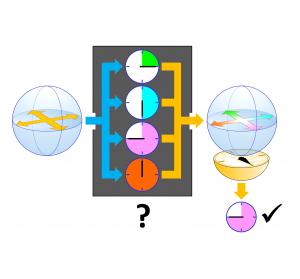
It was proven that the coherence of a quantum state can be directly linked to the advantage in estimating the phase imprinted on the state by a quantum evolution.
Quantum features have puzzled physicists since the birth of quantum mechanics, but such features are presently being tamed in the development of quantum information processing and the next wave of quantum technologies, including quantum cryptography and quantum computers. One archetypal quantum property is quantum superposition, which allows two physical states that ‘classically’ would be considered as mutually exclusive (like a coin being simultaneously heads and tails, or a famous cat dead and alive) to coexist. Quantum coherence is the extent to which this counter-intuitive property is present, despite, for example, various sources of noise. Recently, physicists have been approaching the study of coherence by elevating it to a ‘resource’ to be exploited, and by developing ways to measure the amount of quantum coherence in a system. In two new papers, Marco Piani, a lecturer in the Computational and Nonlinear Quantum Optics group of the Department of Physics at the University of Strathclyde, and a team of physicists and mathematicians at the University of Nottingham, UK, and at Mount Alison University, Canada, have introduced a way to quantify the usefulness of quantum coherence by looking at this property from a purely operational perspective. The new measurement method can answer questions such as “how useful will a system’s quantum coherence be for a task like encoding and decoding messages?” As Piani and collaborators show, the usefulness of quantum coherence can be described by the ‘robustness of quantum coherence’. Basically, this measures how easy or difficult it is to destroy a state’s quantum coherence. The concept is a specific version of a more general measure the scientists introduce: the ‘robustness of asymmetry’. When a quantum system is asymmetrical, it is possible to distinguish between different ‘rotations’ of the system. Physicists can then use it for quantum metrology applications, for example to make extremely precise measurements that would not be possible in the absence of asymmetry, or as a physical reference frame, akin to a gyroscope. Overall, the authors view the results as a step forward in the quest to make the weird features of quantum mechanics into something useful. Besides benefiting physics applications such as quantum metrology and secure communication, the new measure could also be used to quantify quantum coherence in biological systems, such as photosynthesis and bird navigation. “The realization that quantum properties can be harnessed for practical applications is presently fuelling a heated international race to develop and deploy quantum technologies,” the authors wrote. They stress how “the improved study and test of fundamental quantum properties and our increased ability to exploit them go hand in hand.” Carmine Napoli, et al. Robustness of coherence: An operational and observable measure of quantum coherence Physical Review Letters. DOI: 10.1103/PhysRevLett.116.150502 Also at arXiv:1601.03781 [quant-ph] Marco Piani, et al. Robustness of asymmetry and coherence of quantum states Physical Review A. DOI: 10.1103/PhysRevA.93.042107 Also at arXiv:1601.03782 [quant-ph] [Phys.org article]11 [Marco Piani’s Blog Post]12
Entanglement Becomes Easier to Measure

Light scattering experiments measure entanglement in trapped ultra cold atoms (blue spheres). Photo Credit: IQOQI/Ritsch.
Luca Tagliacozzo together with researchers from Innsbruck and Munich have developed a new protocol to detect entanglement of many-particle quantum states using a simple approach. In Quantum Theory, interactions among particles create fascinating peculiar correlations that cannot be explained by any means known to the Classical World. Entanglement is a consequence of strange probabilistic rules of quantum mechanics and seems to permit a peculiar instantaneous connection between particles over long distances that defies the laws of our macroscopic world, a phenomenon that Einstein referred to as “spooky action at a distance”.
Entanglement is a mysterious concept but there is little doubt that it contributes to provide super-powers to quantum systems. It indeed allows to obtain more precise measurements in the field of quantum metrology, to perform faster computations in the field of quantum computations, and to characterize exotic phases in the field of quantum matter. Developing protocols to detect and quantify entanglement of many-particle quantum states is thus a key challenge for current experiments since detecting entanglement becomes very difficult when many particles are involved. In a study recently published in Nature Physics, researchers Dr. Philipp Hauke and Dr. Peter Zoller from the Institute for Theoretical Physics at the University of Innsbruck, in collaboration with Dr. Markus Heyl, from the Technische Universität München, and Dr. Luca Tagliacozzo, Chancellor’s Fellow in the CNQO group of the Department of Physics at the University of Strathclyde, have found a new way to detect certain properties of many-particle entanglement independently on the size of the system. By using the standard measurements techniques available in the laboratories they have proposed a new detection protocol for entanglement, and have shown that by using it one can easily extract information about entanglement in many body systems. For instance, in the case of neutral atoms trapped in optical lattices, their protocol can be implemented by performing ordinary laser spectroscopy. Their protocol allows to measure the Quantum Fisher information, a reliable witness for genuinely multipartite entanglement. The experimental measure of entanglement in many body quantum systems opens a new observational window in the world of quantum matter and will allow to better understand the role of quantum mechanical entanglement in many-body systems and their exotic emerging properties.
Freak waves in an optical bathtub (i.e. Vortices, Turbulence and Rogue Waves in Quantum Optics)
Rogue waves (RW) are rare massive walls of water that appear suddenly and unpredictably out of nowhere, then disappear in a flash leaving no evidence of their existence other than the devastation of the ships that they destroy. Given the immensity of the ocean and the rarity of these events, the mechanism behind the formation of freak waves – and the ability to predict their appearance – is still something of an enigma. Any model capable of quickly generating, studying and predicting rogue waves could have huge potential benefit by allowing ships to navigate safely through these catastrophic events, thus saving both lives and money.
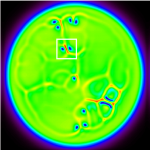
Fig. 1: Vortex pairs.
In a recent Physical Review Letters (Phys. Rev. Lett. 116, 043903, 2016) researchers Christopher J. Gibson, Alison M. Yao and Gian-Luca Oppo of the CNQO group in the Department of Physics have shown that RWs can originate in the transverse area of externally driven lasers and quantum optical devices. Their appearance has been associated with two other familiar concepts in fluids: vortices and turbulence. When the external driving is decreased, optical turbulence sets in and vortices are created and destroyed in pairs (see Figure 1).
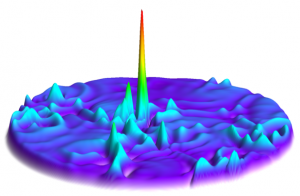
Fig. 2: An optical RW peak that is 27 times the mean fluctuation from the average intensity.
Close to turbulent and interacting vortices they observe that from time to time the light intensity grows enormously thus leading to RWs (Figure 2). Given the universality of the model equations, their mechanism should be observable in a large variety of systems in quantum optics such as solid-state and semiconductor lasers, optical parametric oscillators and polariton condensates. Outside optics, this vortex-mediated turbulence should be observed in nematic liquid crystals, chemical reactions, laser plasma interactions and, of course, fluid dynamics. By understanding the mechanism by which rogue waves occur, new methods for the prediction and, in particular, detection of RW precursors (in this case multi-vortex collisions) can be engineered. Moreover, by exploiting the small spatial scales and fast dynamics of optical systems they have produced a new method to create and study RWs in much smaller configurations and over much shorter time scales: freak waves in an optical bathtub!
Their work was highlighted on phys.org.
Hilbert’s Hotel takes a quantum twist
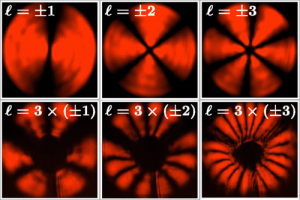 Mathematician David Hilbert introduced a famous mathematical paradox to illustrate the confusing concept of infinity. In this scenario a hotel has an infinite number of rooms, each of which contains a guest. An infinite number of new guests all turn up at reception and ask for a room. Can the hotel accommodate them? The surprising answer is yes. If each guest already in the hotel moves to a room with room number double that of their current room number this frees up an infinite number of rooms for the new guests. Daniel Oi and John Jeffers together with former CNQO members Vašek Potocek and Filippo Miatto in a collaboration including the Czech Technical University in Prague, Glasgow University, the University of Ottawa in Canada, the University of Rochester in New York State and the Institute for Quantum Computing in Waterloo, Canada have described the theory and performed a confirming experiment that mimics this famous paradox. The research shows how to create gaps in a basis of quantum states by moving the state numbered by n to 3n. The extension to Hilbert’s Hotel that quantum physics allows is that not only is the occupied basis state (or room) changed, but the full complex quantum amplitude is moved to the new basis state in a coherent fashion. This means that superpositions of states with different n are maintained. The basis that is used in the experiment is the orbital angular momentum basis of light. The results reported would allow for interleaving of separate quantum states (new quantum guests). The research is reported in Physical Review Letters, PRL 115, 160505 (2015), and is the subject of an APS synopsis. Popular accounts are found here, here, here, here and here.
Mathematician David Hilbert introduced a famous mathematical paradox to illustrate the confusing concept of infinity. In this scenario a hotel has an infinite number of rooms, each of which contains a guest. An infinite number of new guests all turn up at reception and ask for a room. Can the hotel accommodate them? The surprising answer is yes. If each guest already in the hotel moves to a room with room number double that of their current room number this frees up an infinite number of rooms for the new guests. Daniel Oi and John Jeffers together with former CNQO members Vašek Potocek and Filippo Miatto in a collaboration including the Czech Technical University in Prague, Glasgow University, the University of Ottawa in Canada, the University of Rochester in New York State and the Institute for Quantum Computing in Waterloo, Canada have described the theory and performed a confirming experiment that mimics this famous paradox. The research shows how to create gaps in a basis of quantum states by moving the state numbered by n to 3n. The extension to Hilbert’s Hotel that quantum physics allows is that not only is the occupied basis state (or room) changed, but the full complex quantum amplitude is moved to the new basis state in a coherent fashion. This means that superpositions of states with different n are maintained. The basis that is used in the experiment is the orbital angular momentum basis of light. The results reported would allow for interleaving of separate quantum states (new quantum guests). The research is reported in Physical Review Letters, PRL 115, 160505 (2015), and is the subject of an APS synopsis. Popular accounts are found here, here, here, here and here.
NonMarkovianity of Gaussian Channels Typically in quantum physics we make the
Markov approximation, which basically assumes that when information reaches the environment it is lost to the system forever. Systems that do not satisfy this useful approximation can be difficult to treat theoretically, but are becoming increasingly important experimentally. Wojciech Roga and co-workers in Salerno have introduced a new criterion to determine nonMarkovianity in Gaussian channels. The research is published in Physical Review Letters, Physical Review Letters 115, 070401 (2015).
From quantum to classical
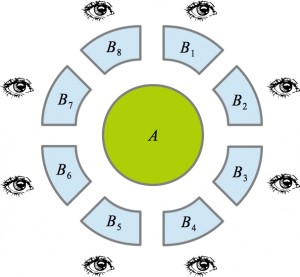
The mechanism for the emergence of objectivity known as quantum Darwinism treats the environment as carrier of information. Observers have indirect access to (the information about) system A through their ability to interact independently with the parts of the environment B.
Understanding how the macroscopic classical world emerges from the microscopic quantum world is a fascinating topic that has been puzzling scientists since the early days of quantum mechanics. This “quantum-to-classical” transition is important both conceptually and for the future of quantum computing. We need to know, for example, if a one-thousand-qubit quantum computer can maintain the quantum features necessary to process quantum information. Quantum Darwinism, a theoretical framework championed by quantum theorist Wojciech Zurek, tries to explain the quantum-to-classical transition and the emergence of classical objectivity, meaning that all observers get the same classical information when interacting with a quantum system. Quantum Darwinism predicts that a quantum system environment is actually a means for information about the system to reach the observer. New research by CNQO’s Marco Piani and collaborators shows for the first time that the emergence of classical objectivity, as described by the quantum Darwinism framework, is actually a direct consequence of the laws of quantum mechanics itself. The results were published in a paper entitled Generic emergence of classical features in quantum Darwinism in Nature Communications (Nature Communications 6, 7908 (2015); pre-print available here).
Optomechanical Self-Structuring in a Bose-Einstein Condensate
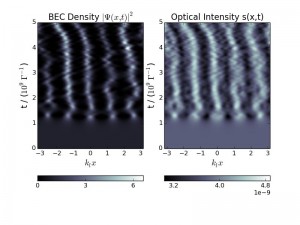
Self-structuring : Both the BEC density and optical intensity display a transition from a spatially homogeneous to a modulated state
A team of researchers from the Optics division have published a paper on Optomechanical Self-Structuring in a Bose-Einstein Condensate (BEC) in Physical Review Letters (PRL 114, 173903 (2015)). The team consists of Gordon Robb, former PhD student Enrico Tesio, Gian-Luca Oppo, Willie Firth, Thorsten Ackemann and visiting professor Rodolfo Bonifacio. The paper describes a theoretical analysis of a BEC interacting with light which, after passing through the BEC, is reflected by a mirror. The BEC-light interaction is shown to give rise to a self-structuring instability in which both the light intensity and the BEC density spontaneously develop spatial modulations resulting in the BEC behaving as a supersolid (see figure). The paper shows that the wave-like nature of the BEC gives rise to an instability threshold which remains finite even at zero temperature, in contrast to similar self-structuring instabilities in classical cold gases.
Lossless Loss at the Quantum Level
John Jeffers and co-workers at Heriot-Watt, Singapore, Southampton and Troyes have performed an experiment that confirms a theoretical prediction made by John Jeffers way back in 2000. A lossy optical medium can become lossless to single photons in the appropriate optical mode. They use a 50nm thin gold film of metamaterial as an absorber that removes 50% of the light that falls upon it. By directing single photons into a path superposition mode they can tune the absorption between 0 and 100%, allowing filtering and control of single photons, The work appeared in the May 2015 issue of Nature Communications, Nature Communications 6, 7031 (2015).
Rapid-Fire Amplification beyond the Quantum Limit but without Quantum Resources
John Jeffers and recent CNQO PhD graduate Electra Eleftheriadou have recently published a paper on the State Comparison Amplifier in Physical Review Letters (PRL 114, 120505 (2015). The work was done in collaboration with Heriot-Watt and Glasgow Universities and the pioneering experiment was performed by Gerald Buller’s group at Heriot-Watt. The device uses coherent states as a resource, which allows for a relatively simple light source, such as a diode laser, providing an increased rate of amplification. Most quantum amplifiers operating in this regime require difficult-to-produce quantum states of light such as single photons. Another feature of the system is that the amplifier is not restricted to low amplitude coherent states, making it useful for slightly higher gain applications.
Congratulations To
Electra Eleftheriadou on passing her viva on Friday 20th March. Electra is off to Canada to work with ex-CNQOer Norbert Lutkenhaus.
Welcome CNQO Welcomes
Luca Mazzarella to the group, Luca will be working on quantum communication schemes with John Jeffers, as part of the £ 20M York-led Quantum Communications Hub.
“Spooky action at a distance” key in telling physical processes apart
Quantum steering embodies the “spooky action at a distance” originally scrutinized by Einstein, Podolsky and Rosen in an attempt to prove quantum mechanics a theory still in need of refinement. We now know that steering is a crucial quantum effect that constitutes a strong manifestation of quantum entanglement. Nonetheless, answers to the question “What is steering useful for?” had previously remained limited.
In their paper “Necessary and sufficient quantum information characterization of Einstein-Podolsky-Rosen steering”, which was published in Physical Review Letters, CNQO group member Dr Marco Piani and Prof John Watrous, at University of Waterloo, break new ground in the study of the usefulness of steering.
They provide a full and precise operational characterization of the steering phenomenon, both qualitatively and quantitatively. They achieve this by relating steering to a fundamental task in quantum information processing: the discrimination of physical processes, i.e., the task of answering a question like “What actually happened to that particle?”. Dr Piani and Prof Watrous prove that the steering effect, when applied to a probe particle entangled with a reference particle, is the key in providing an advantage in this type of task in a scenario where measurements are subject to experimentally relevant limitations.
NJP Highlight of 2014 The paper “
Discriminatory optical force for chiral molecules” by Rob Cameron, Steve Barnett and Alison Yao has been selected to appear in the New Journal of Physics “Highlights of 2014” collection. This collection is a special showcase of articles that have been chosen to represent the breadth of interest and excellence of the work published in the journal last year.
Congratulations
Congratulations to John Jeffers, who was recently elected as an Outstanding Referee by the American Physical Society. He Joins Gian-Luca Oppo and Willie Firth as other current CNQO-ers on the list. Indeed CNQO is the only group in the Department to have anyone on the list ever. The full list of current and ex CNQO staff who have been recognised is
- Erika Andersson (Now at Heriot-Watt University)
- Steve Barnett (Now at Glasgow University)
- Peter Horak (Now at the University of Southampton)
- John Jeffers
- Willie Firth
- Gian-Luca Oppo
Welcome CNQO Welcomes Wojciech Roga to the group, Wojciech will be working on Quantum Enhanced Imaging with
John Jeffers, Alison Yao and Gian-Luca Oppo as part of the £ 29M Glasgow-led Imaging Hub.
EPSRC Quantum Technology Hubs
 CNQO is a partner in the new Quantum Technology Hubs. John Jeffers is part of the £24M York-led Quantum Communications Hub. John Jeffers, Alison Yao and Gian-Luca Oppo are involved in the £ 29M Glasgow-led Imaging Hub. More Information: See the EPSRC press release, or the University News Item for more Strathclyde Physics involvement in the Hubs. Strathclyde is the only partner University in all four Hubs, as you can see from this BBC story.
CNQO is a partner in the new Quantum Technology Hubs. John Jeffers is part of the £24M York-led Quantum Communications Hub. John Jeffers, Alison Yao and Gian-Luca Oppo are involved in the £ 29M Glasgow-led Imaging Hub. More Information: See the EPSRC press release, or the University News Item for more Strathclyde Physics involvement in the Hubs. Strathclyde is the only partner University in all four Hubs, as you can see from this BBC story.
New CNQO Book
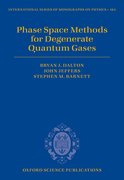 John Jeffers has published a book, together with Visiting Professor Bryan Dalton and former CNQO Professor Steve Barnett. It’s published by OUP, found here. It’s simply marvellous and makes an excellent Xmas stocking filler.
John Jeffers has published a book, together with Visiting Professor Bryan Dalton and former CNQO Professor Steve Barnett. It’s published by OUP, found here. It’s simply marvellous and makes an excellent Xmas stocking filler.
EPSRC Grand Challenge Network “Emergence and Physics far from Equilibrium”
Workshop on
Non-Equilibrium Processes at Negative Temperature
Collins Building, University of Strathclyde, Glasgow 23-24 October 2014
To register see: http://negt2014.phys.strath.ac.uk/
Workshop on
Many-body Dynamics and Open Quantum Systems
20th– 22nd October 2014 Grand Central Hotel, Glasgow, Scotland
For more information see: http://doqs2014.phys.strath.ac.uk
Quantum sealing with classical wax
John Jeffers, and co-workers at Heriot-Watt and Edinburgh Universities, have implemented a quantum digital signature protocol that does not require the quantum signature to be stored in quantum memory. They use unambiguous state discrimination to identify (sometimes) definitely the nonorthogonal states that form the signature. This measured signature is stored in normal computer memory. The team members extend the technique using unambiguous state elimination which, when they cannot determine the signature precisely, allows them at least to say what it was not – increasing the chance that a signature-forger reveals themselves. The work has been selected as an Editor’s Suggestion in July 2014 Physical Review Letters, Phys. Rev. Lett. 113, 040502 (2014) and is spotlighted in the Viewpoint section of Physics.
Tunnelling Dynamics of many interacting atoms in an optical lattice
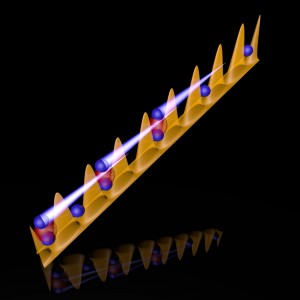 Quantum tunnelling manifests itself in a multitude of well-known microscopic phenomena. Experimental physicists in the group of Hanns-Christoph Nägerl in Innsbruck, Austria, in collaboration with CNQO theorist Andrew Daley have now directly observed atoms transmitted through up to five potential barriers under conditions where a single particle would not be able to move. The corresponding out-of-equilibrium many-body dynamics is both of fundamental interest, and sets the stage for further studies of complex models and dynamics far from equilibrium in quantum simulators. This work was published in the journal Science.
Quantum tunnelling manifests itself in a multitude of well-known microscopic phenomena. Experimental physicists in the group of Hanns-Christoph Nägerl in Innsbruck, Austria, in collaboration with CNQO theorist Andrew Daley have now directly observed atoms transmitted through up to five potential barriers under conditions where a single particle would not be able to move. The corresponding out-of-equilibrium many-body dynamics is both of fundamental interest, and sets the stage for further studies of complex models and dynamics far from equilibrium in quantum simulators. This work was published in the journal Science.
Diffraction Gratings for Chiral Molecules
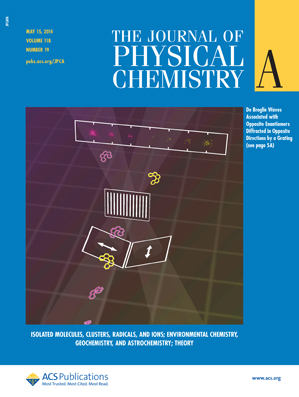 Recent work by Alison Yao together with Robert Cameron and Steve Barnett of the Glasgow Quantum Theory group made the front cover of Journal of Physical Chemistry A in May 2014. The paper reports a new method of using optical forces to separate chiral molecules. This could have applications in discriminating enantiomers of chiral molecules.
Recent work by Alison Yao together with Robert Cameron and Steve Barnett of the Glasgow Quantum Theory group made the front cover of Journal of Physical Chemistry A in May 2014. The paper reports a new method of using optical forces to separate chiral molecules. This could have applications in discriminating enantiomers of chiral molecules.
Congratulations!
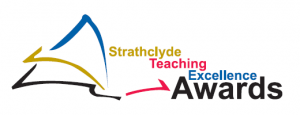 Congratulations to Prof Gian-Luca Oppo who was awarded Most Enthusiastic Teacher at the Strathclyde Teaching Excellence Awards 2014. The award recognises lecturers who demonstrate enthusiasm about their particular subject, creating an exciting and inspiring learning environment for students. Their enthusiasm and passion for their subject encourages students to seek out further learning and they offer intellectually challenging experiences to students which are deemed enjoyable. Congratulations also to Dr. Nigel Langford, who won the award for the Most Supportive Teacher (and to Alison Yao, who was also nominated for an award).
Congratulations to Prof Gian-Luca Oppo who was awarded Most Enthusiastic Teacher at the Strathclyde Teaching Excellence Awards 2014. The award recognises lecturers who demonstrate enthusiasm about their particular subject, creating an exciting and inspiring learning environment for students. Their enthusiasm and passion for their subject encourages students to seek out further learning and they offer intellectually challenging experiences to students which are deemed enjoyable. Congratulations also to Dr. Nigel Langford, who won the award for the Most Supportive Teacher (and to Alison Yao, who was also nominated for an award).
Welcome
We are very happy to welcome
Prof Andrew Daley to the group. Andrew’s research interests focus on the overlap between quantum optics and many-body physics, especially in systems of ultracold atoms. This work has applications to the use of atomic and molecular systems as quantum simulators of complex materials and other quantum technologies, as well as fundamental studies of out of equilibrium dynamics in quantum systems.
Dirac Medal Winner
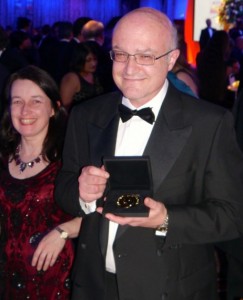 Prof Steve Barnett has been awarded the prestigious Institute of Physics 2013 Dirac Medal for his wide ranging contributions throughout optics research, which both inspire and lead experimental endeavours. This medal is awarded annually in recognition of outstanding contributions to theoretical physics.
Prof Steve Barnett has been awarded the prestigious Institute of Physics 2013 Dirac Medal for his wide ranging contributions throughout optics research, which both inspire and lead experimental endeavours. This medal is awarded annually in recognition of outstanding contributions to theoretical physics.
Measuring Nothing
Daniel Oi, John Jeffers and Václav Potoček have shown how to measure nothing. Specifically, they showed how to find out whether there are any photons in a quantum field without disturbing its coherence in the case the vacuum is not found. This requires that no information is gained about the number of photons in the field, apart from the fact that there is at least one. They suggest using a three-level atom controlled by a laser to probe the field stored in a cavity using an adiabatic transition. Moreover, modelling suggests that the process is robust against common sources of imperfection. The results have been selected to be an Editor’s Suggestion in Physical Review Letters Phys. Rev. Lett. 110, 210504 (2013) and are spotlighted in the Synopsis section of Physics
Quantum physics fights against crime Physicists at the University of Strathclyde and Heriot-Watt University have developed a new way of verifying electronic transactions using light.
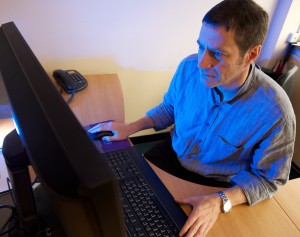 Their approach uses photons to create digital signatures, the security of which are based on the laws of quantum physics. The team includes CNQO’s Dr John Jeffers. Their advance could help tackle the huge burden of e-crime, which is estimated to cost £205 million in the UK retail sector alone. Their work, recently published in the journal Nature Communications, was reported on the BBC news website. More information can be found on the following pages:
Their approach uses photons to create digital signatures, the security of which are based on the laws of quantum physics. The team includes CNQO’s Dr John Jeffers. Their advance could help tackle the huge burden of e-crime, which is estimated to cost £205 million in the UK retail sector alone. Their work, recently published in the journal Nature Communications, was reported on the BBC news website. More information can be found on the following pages:
* University news page
* Yahoo news
* AllmediaScotland
